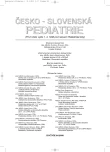Acute Neuroborrelioses in Children
Authors:
P. Kosina; S. Plíšek; J. Krausová; R. Kračmarová
Authors‘ workplace:
Klinika infekčních nemocí, Lékařská fakulta a Fakultní nemocnice, Hradec Králové
přednosta MUDr. S. Plíšek, Ph. D.
Published in:
Čes-slov Pediat 2009; 64 (5): 230-235.
Category:
Original Papers
Overview
Introduction:
The affection of the central nervous system related to borrelia etiology belongs to frequent diseases, but there is still lack of agreement in diagnostic criteria. At the child age the disease occurs at a lower rate than in adult individual patients and a corresponding antibiotic therapy results to complete recovery in most cases.
Methods and results:
Prospective analysis was performed in 33 children with diagnosis of acute neuroborreliosis and the evaluation of anamnestic data, finding in cerebrospinal fluid and serum, effects of therapy and permanent consequences. In 26 children the clinical picture included paresis of one of the cranial nerves, six children underwent the disease under the clinical picture of aseptic meningitis and one patient suffered from a severe meningoencephalitis with affected consciousness. The treatment included the intravenous administration of antibiotics for the period of three weeks. The subsequent two-year follow-up revealed a high percentage of complete recovery in the children patients observed.
Conclusions:
In patients with the picture of aseptic meningitis and pareses of cranial nerves, borelia etiology should always be in mind. At the present time there is not any reliable laboratory method in the diagnostics – available direct and indirect proofs of the causal agent should be combined with anamnesis and epidemiological data.
Key words:
neuroborreliosis, paresis, meningoencephalitis, anti-borrelia antibodies
Sources
1. Pícha D. Patogeneze. In: Bartůněk P. Lymeská borelióza. Praha: Grada, 2001: 33–38.
2. Kahl O, Janetzki-Mittmann C, Gray JS, et al. Association between different clinical manifestation of Lyme disease and different species of Borrelia burgdroferi sensu lato. Res. Microbiol. 1995;146: 329–340.
3. Gray JS, et.al. Lyme borreliosis – biology, epidemiology and control. CABI Publishing 2001;2: 47–48.
4. Roháčová H. Lymská borelióza. Causa subita 2003;244–246.
5. Steere AC. Lyme disease. N. Engl. J. Med. 2001;345: 115–125.
6. European Union concerned action on Lyme Borreliosis – Treatment of Lyme Borreliosis in Europe.Avaible from: www//vie.dis.strath.ac.uk/vie/LymeEU/treatment in-europe.html.
7. Burrascano J. Diagnostic hints and treatment guidelines for Lyme and other tick-borne illnesses. 2002. Avaible from: www.ilads.or/burrascano 1102.htm.
8. Štruncová V, Sedláček D, Šubrt I, et al. Možnosti využití skórovacího systému v diagnostice lymeské boreliózy. Prakt. Lék. 1999;79: 686–690.
9. Krbková L. Lymeská borelióza. In: Bartošová D. Dětské infekční nemoci. Praha: Galén, 2003: 189–196.
10. Eppes SC. Diagnosis, treatment and prevention of Lyme disease in children. Paediatr. Drugs 2003;5: 363–372.
11. Honegr K, Dostál V. Klinické projevy a léčba lymeské boreliózy. Klin. mikrobiol. inf. lek. 2004;1: 5–10.
12. Vukelic D, Bozinovic D, Morovic M, et al. Opsoclonus-myoclonus syndrome in a child with neuroborreliosis. J. Infect. Dis. 2000;40: 189–191.
13. Stankovič I. Lymská borelióza. In: Bálint O. Infektológia a antiinfekčná terapia. Martin: Osveta, 2007: 273–276.
14. Skogman BH, Croner S, Nordwall M, Eknefelt M, Ernerudh J, et al. Lyme neuroborreliosis in children. Pediatr. Infect. Dis. J. 2008;27: 1089–1094.
15. Lásiková Š, Moravcová L, Pícha D, Žďárský E. Dynamika polymerázové řetězové reakce (PCR) a její význam v diagnostice lymeské neuroborreliózy. Čes. a Slov. Neurol. Neurochir. 2003;66/99: 44–49.
16. Pícha D, Moravcová L, Žďárský E, Marešová V, Hulínský V. PCR in Lyme neuroborreliosis – a prospective study. Acta Neurol. Scand. 2005;112: 287–292.
17. Roháčová H. Lymeská borelióza. Praha: Maxdorf, 2005: 21–32.
18. Hulínská D, Krausová M, Janovská D, Roháčová H. Electron microscopy and nad the polymerase chain reaction of spirochete of patients with Lyme Disease. Centr. Eur. J. Publ. Health 1993;37: 81–85.
19. Pavia CS. Current and novel therapies for Lyme disease. Expert Opin. Investig. Drugs 2003;12: 1003–1016.
20. Pavia CS, Wormser GP, et al. Efficacy of an evernimycin (SCH 27899) in vitro and animal model of Lyme disease. Antimicrob. Agents Chemother. 2001;45: 936–937.
21. Roháčová H. Lymeská borelióza. In: Havlík J, et al. Infekční nemoci. 2. vyd. Praha: Galén, 2002: 119–122.
22. Marešová V, Roháčová H. Third generation of cephalosporins in the treatment of patients of Clinic of Infectious Diseases of Bulovka Hospital, Prague. In: Abstr. Croatian Congress of Infectious Diseases with International Participation; Dubrovník 1998.
23. Stanek G, Strle F. Lyme borreliosis. Lancet 2003;362: 1639–1647.
24. Moravcová L, Pícha D, Lásiková Š, Žďárský E. Porovnání dvou metod – průkazu intratékální syntézy specifických antiboreliových protilátek a polymerázové řetězové reakce – v diagnostice lymeské neuroboreliózy. Čes. a Slov. Neurol. Neurochir. 2003;66/69: 121–125.
25. Pícha D, Moravcová L, Lásiková Š, Holečková D, Marešová V. Symptoms of „post-lyme“ syndrome in long-term outcome of patients with neuroborreliosis. Scand. J. Infect. Dis. 2006;38(8): 747–748.
Labels
Neonatology Paediatrics General practitioner for children and adolescentsArticle was published in
Czech-Slovak Pediatrics

2009 Issue 5
Most read in this issue
- Recent Trends in Diagnosis of Fetal Alcohol Syndrome
- Acute Neuroborrelioses in Children
- Molecular Diagnostics of Hereditary Unconjugated Hyperbilirubinemias in Slovakia
- Standards of the Multidisciplinary Treatment of a Child with Orofacial Cleft
